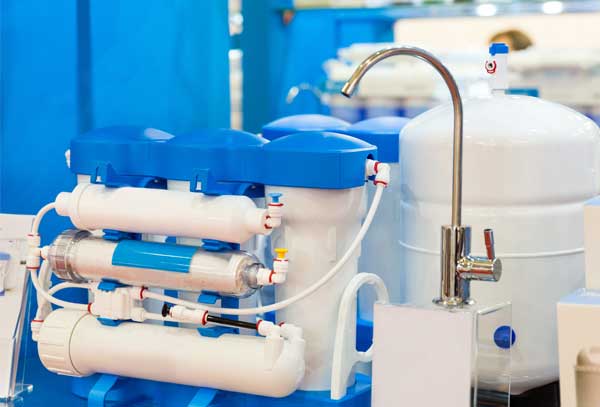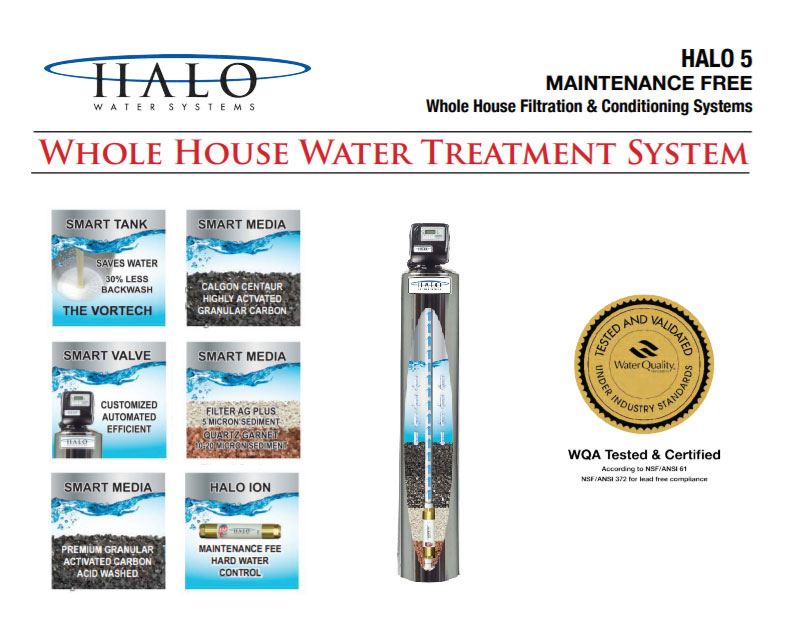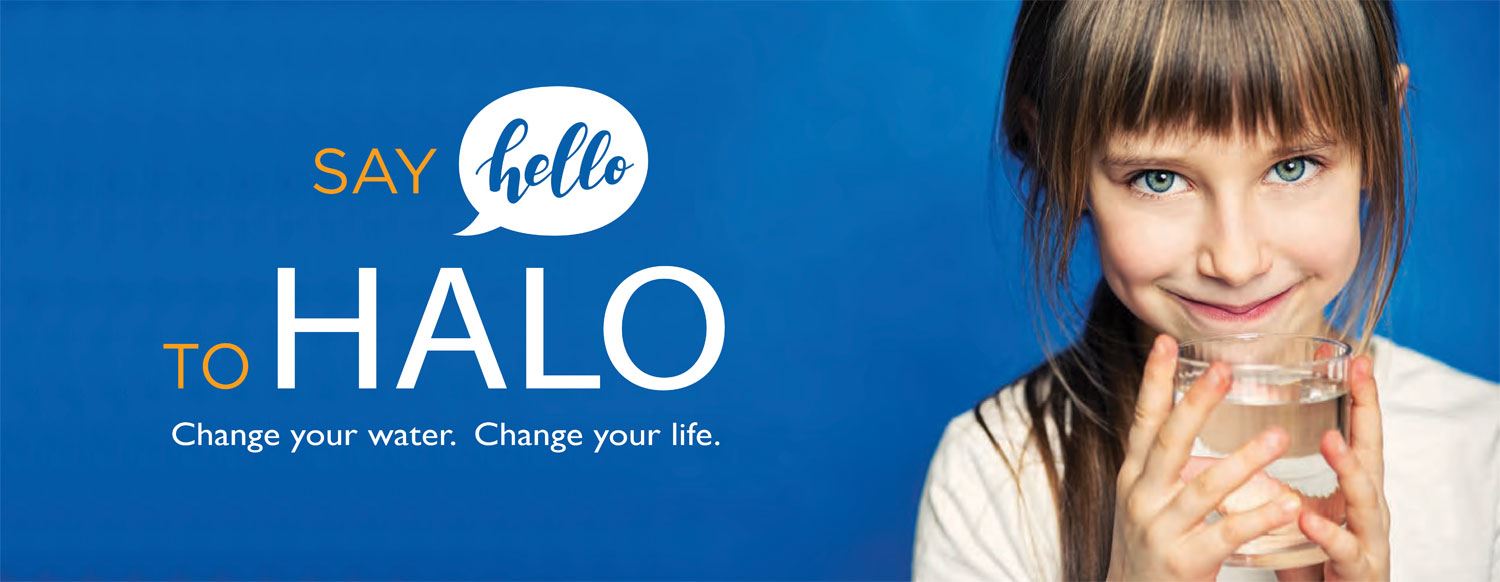
Water filtration systems can help tackle many concerns of plumbing. More specifically, a whole house water filtration unit can keep your water clean and safe, your family healthy, and the cost of bottled water low. Learn how this system works, its pros and cons, and how to choose the most suitable option for your home.
What is a Water Filtration System?
A water filtration system helps improve water quality by removing or reducing suspended solids, inorganic chemicals, biological contaminants, and other impurities.
There are two primary types of water filters: ion exchange and reverse osmosis.
Reverse osmosis filters use pressure to push water through a semipermeable membrane, leaving behind the contaminants. While this type of water filter can remove all particles, chemicals, and pollutants, it may affect the composition of essential minerals like calcium and magnesium in drinking water. That is why modern models incorporate an alkalization stage that balances water pH and adds the minerals back in.
Ion exchange water purifiers soften hard water through the reversible exchange of like-charged ions. The process involves exchanging calcium and magnesium ions in hard water with hydrogen or sodium ions.
Also available are ultraviolet systems that purify water by destroying the DNA of living organisms, rendering them incapable of spreading disease in the water supply. However, such a system requires that you first treat the water supply with a sediment filter to remove dirt and debris (which may shield microorganisms from UV light).
The units can also be classified by the type of contaminant they remove, type of media, and installation location.
Water filtration systems vary in flow rates – the volume of water purified over a given period. They can be installed directly to a plumbing fixture (inline water filters) or main supply line (point of entry/whole house water filters).
Inline water filters, also known as point-of-use (POU) filters, are inexpensive, but they only protect singular water sources in your home. Variations include under-the-sink, faucet, and countertop filters.
Schedule a Visit
Table of Contents
- How Does a Whole House Water Filtration Work?
- 1. Sediment Filtration
- 2. Activated Carbon Filtration
- 3. Post Filter Stage
- Types of Common Water Contaminants
- Things to Consider When Going with a Whole House Water Filtration (vs. under sink and countertop filters)
- » Quality of Water
- » Water Consumption
- » Flow Rate
- » Longevity and Maintenance
- » NSF Certification
- Advantages and Disadvantages of a Whole House Water Filtration System
- Get a Whole House Water Filtration System for Your Ventura Home

How Does a Whole House Water Filtration Work?
Also known as a point-of-entry (POE) filter, a whole house water filter sits on your main water supply line, providing clean, filtered water throughout your entire home.
Here are few reasons to install a point-of-entry water filter:
- If your home’s water supply is generally poor quality
- To remove sediment from and disinfect well water
- To remove chlorine taste and odor from the city water supply
- To soften hard water
If you are only concerned about filtering drinking and cooking water, investing in a point-of-use filter makes more economic sense. But if you want to enjoy the confidence that water flowing from all your plumbing fixtures and through water-consuming appliances is clean and safe, a point-of-entry filter is a good fit.
Gallegos Plumbing’s partnership with HALO Water Systems allows us to upgrade your existing water filters with some of the country’s best water systems. Among them is the HALO 5, a whole house water filter designed to offer a long-lasting water filtration solution with little to zero maintenance. It is best suited for resolving hard water and chlorine issues in municipal water.
Suppose you intend to use HALO 5 to treat well water. In that case, the manufacturer recommends having a professional first perform a thorough well-water analysis to ensure the system meets your expectations.

Generally, a whole-house system treats water in the following stages:
1. Sediment Filtration
The first stage in a point-of-entry water filter is trapping sizable impurities such as sediment and sand – anything about 5 microns in size. Safeguarding your pipes by 24 hrs plumber from these particulates means safer water and long-term prevention of damage to your plumbing and appliances.
Depending on your water quality and sediment labels, your pre-filter cartridge may require frequent replacements. A lower flow rate or a change in filter color indicates a clogged cartridge.
HALO 5 filter incorporates the clinoptilolite-based Filter AG Plus to filter out the suspended matter as small as 3 microns and High-Density Garnet to trap fine particles in the range of 10-20 microns.
2. Activated Carbon Filtration
Activated carbon is made from raw organic material with high-carbon content (coconut shells, coal, wood, etc.). The material gets heated into char and then treated to produce a porous and high-surface-area product that binds to specific impurities, removing them from the water through the adsorption process.
HALO 5 whole house water filter uses NSF-certified GAC (granular activated carbon) to remove chemicals and organic substances that cause unpleasant smells and tastes in household water. These impurities include herbicides, pesticides, heavy metals, fuels, chlorine, dyes, and disinfectants. The system also features Centaur High Activity Carbon responsible for the decomposition of chloramines and hydrogen sulfide removal.
3. Post Filter Stage
A post-filter helps catch any remaining organic particles and sediment that might be lurking in your household water.
Water softening typically occurs in the final stage of whole house water filtration. HALO 5 uses the eco-friendly HALO ION inline water conditioner to remove water hardness.
Pairing your whole house filter with a UV light purifier can help cut off 99.9% of bacteria and viruses from your water.
Types of Common Water Contaminants
There are a variety of contaminants that you can find in drinking water. Below are some of the most prevalent:
- Particulates. Particulate matter, including sand and dirt, is the most prevalent water pollutant. Particulates in water originate from soil erosion, construction sites, industrial pollution, severe weather events (floods), and the decomposition of animals and plants.
- Lead and Mercury. These heavy metals were common in home plumbing fixtures, lead water pipes, and even in paints until well-publicized problems associated with lead poisoning led to their removal from consumer products.
- Bacteria and viruses. Bacteria and viruses are present in most drinking water sources, including lakes, ponds, and rivers, which tend to be more susceptible to contamination.
- Chemicals. Chemicals in drinking water are generally unwanted by-products from water treatment processes, such as chlorine and chloramine. Agricultural chemicals such as pesticides, herbicides, and fertilizers can also contaminate drinking water.
- Radon. Radon is a naturally occurring radioactive gas found in soil, rocks, and well water. The tasteless, odorless, and colorless gas can get into drinking water and escape into the air through open plumbing fixtures.
- Radioactive solids. Radioactive materials, such as uranium, thorium, and radium, are usually naturally occurring in soil, water, and air.
Things to Consider When Going with a Whole House Water Filtration (vs. under sink and countertop filters)
Different water systems are available in a range of features and specifications tailored to varying water filtration needs. Here are the top considerations for a whole house water filtration system:
» Quality of Water
Water quality issues include sediment impurities, chlorinated water, and salinated water. A lab test can help determine the quantity and types of contaminants in your water. Use the results to determine the appropriate system for your needs.
» Water Consumption
The level of water consumption in your home determines the size and capacity of the filtration system. A fully functional filtration system must supply all water outlets in your home. It must also match your household water consumption level. A smaller-sized unit may be cheaper but may need replacing sooner than expected due to a mismatch in capacity and requirements.
» Flow Rate
Denoted by gallons or liters per minute (GPM or LPM), the flow rate refers to the volume of water that the filter can treat per unit of time. Ensure that the filter rate of the system you are interested in corresponds to your need. A piece of equipment offering a filter rate of 2-8 gallons per minute can comfortably serve a family of four. A family of six will need at least 12 GPM.
» Longevity and Maintenance
Water filter longevity directly relates to its capacity.
For example, a system rated 300,000 gallons may require replacing after three years but can run longer if the water consumption level is considerably low. A 1,000,000-gallon system (best suited for a bigger family) offers a longer lifespan (ideally ten years).
Most water filtration systems require biannual maintenance—some demand more frequent cartridge replacements to enhance system performance and longevity. Make sure you understand the type of maintenance (and associated costs) required to keep a particular system in top shape. Subsequently, determine whether it is something you can commit to.
» NSF Certification
Regardless of the capacity, flow rate, and other features you are looking for in a whole-house water filter, make sure the option you pick is NSF certified. NSF (National Sanitation Foundation) is authorized by the American National Standards Institute (ANSI) to ensure high standards in all water filtration solutions available.
An NSF-certified whole house water filtration system like the HALO 5 is safe to use and incorporates FDA-approved polypropylene cartridges. That translates into higher quality filters, quicker filtration, and higher value for investment.
Advantages and Disadvantages of a Whole House Water Filtration System
The benefits of a point of entry water purifier include:
- Removes various contaminants, giving you the peace of mind that every drop of water entering your home is clean and safe.
- It helps protect your plumbing and water appliances from corrosion and limescale damage, thus prolonging their lifespans.
- Improves the smell and taste of household water
- Removes chloramine often linked to digestive, kidney, and skin issue
- Allows for healthier baths and showers by eliminating chemicals from household water
- Eliminates the need to buy bottled water, reducing associated costs and plastic pollution
The downsides of a whole-house water filter include:
- The initial cost of point of entry water filters can be hundreds of dollars more than that of inline water filters
- They require professional installation, which adds to the initial investment
- You may notice a decrease in water pressure if multiple fixtures are running simultaneously. Pairing your filter with a water booster pump can help resolve this issue.
Get a Whole House Water Filtration System for Your Ventura Home
At Gallegos Plumbing, we offer top-notch whole house water filtration solutions and plumbing services in Ventura County.
With our collaboration with HALO Water Systems, you can now be a proud owner of a top-of-the-line water system that guarantees superior hard water control. Plus, solid prevention against sediment contamination, microbe contamination, chlorine damage, and mineral scaling.
Call us today at (805) 243-2622 for immediate assistance with water quality analysis and water filter installation, repair, maintenance, and replacement in Ventura County and surrounding communities.

